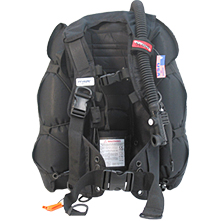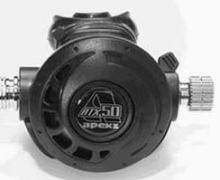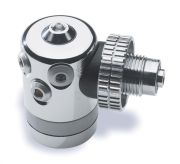Just came back from a day dive trip with Rhichie. It was supposed to be a reunion of sorts of my advanced open water (AOW) classmates but at the last moment, everyone begged off. Only Rhichie and I were left but we decided to push through anyway. We drove to Aquaventure and met up with Norman, our AOW instructor, for the dive. With him were Seema, a new diver, and Kiko, our underwater videographer for the day.
First dive, at Mainit, was hohummm. The vis was great but there was nothing much to see. The second dive was more exciting. Waay more. We dived Layag-layag but we encountered a very strong tidal downcurrent. It was so strong that the fishes were no longer minding our presence and were just swimming to keep their position. It’s so interesting observing them up close and motionless. But the current was so strong that we had to essentially abort the dive. As we ascended, air bubbles we were making were no longer rising up but were staying around the depth they were made. It was quite a sight: thousands of bubbles filled the water. After surfacing, the boat came to pick us up and delivered us back to the resort for lunch.
After lunch, Seema left for Manila while the rest of us rested for the third dive. Just as soon as we prepared for the third dive, it started to rain and I was growing a bit lazy about taking it. But I decided to anyway since I’ve already committed to it. And good thing too because we saw not one but two blue spotted rays, two rock fishes, and some weird bottom-dwelling winged fish. That dive definitely made my day.
 The Zeagle Scout is a back inflation bouyance compensator (BC). With back inflation BCs, the inflating part of the BC is located only at the back. Because of this, you won’t experience squeeze as in jacket-style BCs when you fully inflate. As an added advantage, this configuration allows you to more easily keep a horizontal orientation underwater. This is the best position for minimizing drag when moving along.
The Zeagle Scout is a back inflation bouyance compensator (BC). With back inflation BCs, the inflating part of the BC is located only at the back. Because of this, you won’t experience squeeze as in jacket-style BCs when you fully inflate. As an added advantage, this configuration allows you to more easily keep a horizontal orientation underwater. This is the best position for minimizing drag when moving along. The Apeks ATX50 is the descendant of the famous AT50 regulator favored by many advanced divers. But it is smaller and lighter. It has a pressure balanced system which reduces breathing effort at depth. It also has venturi control and cracking resistance control to adjust breathing performance to your taste. I tend to just put them all at the max setting, though. The only less-than-good thing about the ATX50 is the exhaust which is rather small and if you’re upright, delivers exhaust bubbles straight up your face. But then you won’t be staying upright most of the time, will you? ;)
The Apeks ATX50 is the descendant of the famous AT50 regulator favored by many advanced divers. But it is smaller and lighter. It has a pressure balanced system which reduces breathing effort at depth. It also has venturi control and cracking resistance control to adjust breathing performance to your taste. I tend to just put them all at the max setting, though. The only less-than-good thing about the ATX50 is the exhaust which is rather small and if you’re upright, delivers exhaust bubbles straight up your face. But then you won’t be staying upright most of the time, will you? ;) Since I seem to be on a scuba phase of my preoccupation cycle, I’ll post some scuba related reviews. I’ll start with the Apeks DS4. This 1st stage regulator is a no-nonsense device. It has a dry-sealed (DS) system which means it has a sealing outer diaphragm which transmits pressure over the primary diaphragm. The water doesn’t get in contact with internals and freeze things in cold water. It is also overbalanced. This means the deeper you get, slightly more pressure is delivered to the 2nd stage regulator. It has 4 medium-pressure ports, and 1 high-pressure port. It came with a DIN fitting so I needed a yoke adapter for using it with the tanks that are commonly available locally.
Since I seem to be on a scuba phase of my preoccupation cycle, I’ll post some scuba related reviews. I’ll start with the Apeks DS4. This 1st stage regulator is a no-nonsense device. It has a dry-sealed (DS) system which means it has a sealing outer diaphragm which transmits pressure over the primary diaphragm. The water doesn’t get in contact with internals and freeze things in cold water. It is also overbalanced. This means the deeper you get, slightly more pressure is delivered to the 2nd stage regulator. It has 4 medium-pressure ports, and 1 high-pressure port. It came with a DIN fitting so I needed a yoke adapter for using it with the tanks that are commonly available locally.